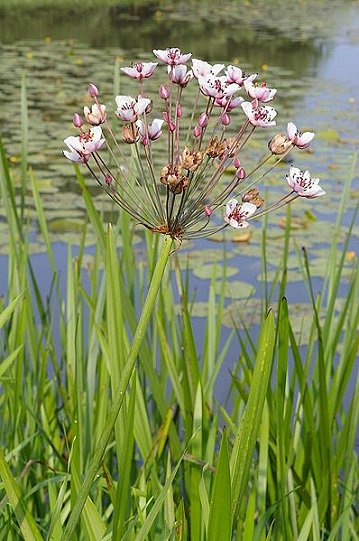
|
|
Flowering rush
( Butomus umbellatusi)
|
Flowering rush - Butomus umbellatus
Butomus is the sole genus in the monogeneric plant family Butomaceae, containing the single species Butomus
umbellatus, also known as flowering rush or grass rush.
The plant is a rhizomatous, hairless, perennial aquatic plant. Its name is derived from Greek
bous, meaning "cow", "ox" etc. and tome, a cut (the verb 'temnein' meaning
"to cut"), which refers to the plant's swordlike leaves. Butomus,
áccording Theophrastus, is from the Greek bous and temno, because the leaves cut the mouths of
cattle; and the second Latin name refers to the umbellate inflorescence.
This plant is called Flowering Rush, Water Gladiole. Gerarde says of
it: "The water-gladiole or grassie-rush is of all others the fairest and most pleasant to behold and serveth very well for the decking and trimming up of
houses, because of the beautie and braverie thereof ".
Other than suggested by its English common name, it is not a true rush. It is native to Eurasia and grows on the margins of still and slowly moving water down to a depth of about 3 m. It has pink
flowers. Introduced into North America as an ornamental plant it has now become a serious invasive weed in the Great Lakes
area. In Israel, one of its native countries, it is an endangered species due to the dwindling of its
habitat. It can also be found in Great Britain locally, for example Butomus umbellatus at Gwent Levels SSSI on the Caldicot and Wentloog
Levels.
Like many other aquatic plants, the aerial stem is a scape with many
sword-shaped, long leaves up to 1 metre, or more, surrounding
it, and giving it a grasslike habit. The leaves are 3-sided, spongy, twisted, and very
sharp, hence the first Greek name. The base of the stem is reddish, like the
flower-stalks also. The leaves are sheathed at the base.
The scape is smooth, round, bearing a single umbel of large numerous flowers (20-30 in an
umbel), rose-colour, red, purple, the perianth-segments oblong at first with 4
grooves, then more or less heart-shaped. The bracts have a membranous margin. The involucre is in
threes, the corolla consists of 6 petals, and there are 9 stamens, 6 pistils, and later 6
capsules. It flowers from July until September.
B. umbellatu is a herbaceous perennial, propagated by
division.
Butomus umbellatus grows in marshes and can tolerate
water as deep or deeper than that in which cattail is normally found (up to 2
metres), extending to the deepest range of emergent marsh species. B. umbellatus
is mostly found on shores of lakes, ponds and riverbanks, and it is intolerant
of salt or brackish water.
Butomus umbellatus become a serious invasive weed
in North America. It can displace native riparian
vegetation, and can be an obstacle to boat traffic. Once established,
populations' increase and can persist indefinitely. Control of this species is very
difficult, especially with herbicides because they easily wash away from the narrow leaves of this
plant. Extensive physical methods of control must be employed to manage this invasive
exotic. It can be spread over long distances by garden planting, and once established in a watershed it spreads locally by rhizomes and root pieces that break
off. Muskrats use parts of the plant and contribute to its local spread. Boaters can also transport flowering rush on their
equipment. In several states of USA, it is illegal
to buy or sell flowering rush.
However B. umbellatus remains popular and it is cultivated as an ornamental waterside
plant. It has gained the Royal Horticultural Society's Award of Garden Merit.
The leaves are used in making mats and baskets. In parts of Russia the rhizomes are used as
food. Baked rootstocks are used as substitute for bread. Flowering rush tuber can be
cooked. It should be peeled and the rootlets removed. The root can also be dried and ground into a
powder; it can then be used as a thickener in soups etc, or be added to cereal flours when making
bread. It contains more than 50% starch.
Source:
http://en.wikipedia.org/wiki/Butomus
http://www.pfaf.org/user/Plant.aspx?LatinName=Butomus+umbellatus
http://unsw.discoverlife.org/mp/20q?search=Butomus+umbellatus
http://chestofbooks.com/flora-plants/flowers/
British-Wild-Flowers-1/Flowering-Rush-Butomus-Umbellatus-L.html
